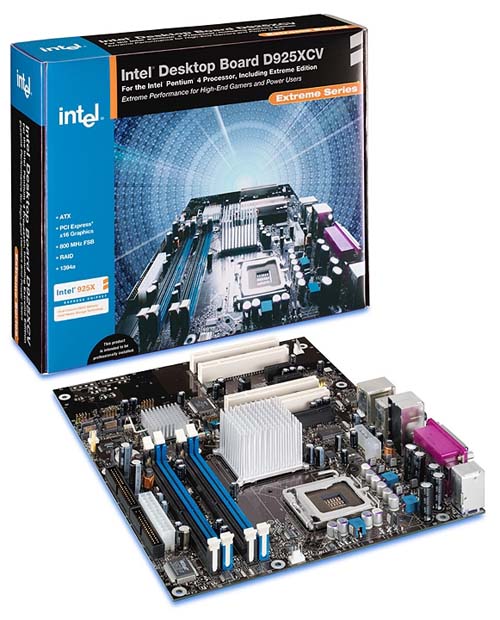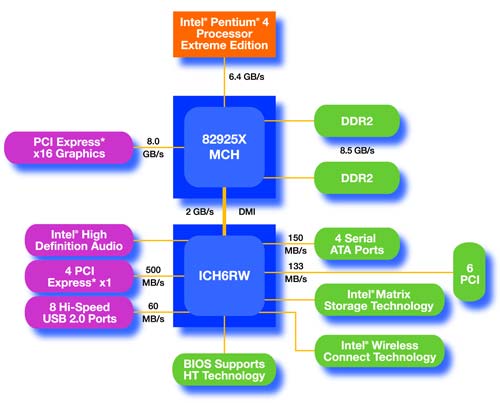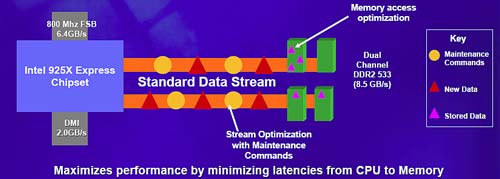Intel 925X/915: Chipset Performance & DDR2
by Wesley Fink on June 19, 2004 3:01 AM EST- Posted in
- CPUs
Intel 925X Express
The Intel D925XCV is the Enthusiast version flagship for all the new Intel technology.
That is not to say Enthusiasts will stand in line to buy the new Intel board, since Intel has not traditionally supported the kinds of features and adjustments that will sway enthusiasts to buy a high-end Intel motherboard. The top Intel motherboard is always, however, a top-performing motherboard at default speeds, and it becomes the chipset performance standard. It is also the standard-bearer for Intel chipset features.
If you look carefully, you will see that the power connectors on the new motherboards, both 925X and 915, are 24-pin, and not the common 20-pin ATX connectors on current Pentium 4 power supplies. We found that server grade power supplies providing 24-pin connectors work fine on the new boards. However, if you have a new top-line PCIe graphics card you will likely find a new 6-pin power connector on the graphics card. You will need either a new power supply with the 6-pin graphics connector or a converter cable that allows two 4-pin molex to be combined in a 6-pin connector to power the new high-end PCIe cards. This is true of both 925X and 915 boards.

925X only supports DDR2 and PCI Express 16X graphics. 925X is also the only 775 chipset version that is stated to support ECC memory. We were not able to verify ECC support, since we did not have access to DDR2 ECC memory. The other features are related to the ICH6 version used with 925X, though you will more likely see ICH6R and ICH6RW (pictured here) paired with 925X.
The other distinguishing feature of Intel 925X is accelerated performance modes compared to 915 chipsets. Intel first differentiated their "Enthusiast" board with enhanced performance on the 875 chipset. The 875 chipset featured PAT, or Performance Acceleration Technology, which was supposed to be a unique feature of the 875 chipset. Chipset manufacturers began revising 865 boards to support PAT-like performance almost as soon as Intel launched 865/875. This was not a development that pleased Intel.

This time around, Intel is also differentiating their top chipset with enhanced performance. Intel did not share any catchy names like PAT, and the diagram above is the only information that they provided on how they make the 925X faster. When we asked for more information than the almost meaningless diagram above, Intel said their acceleration methods were "proprietary". This is not really a surprise after the PAT confusion with 875/865. Industry sources tell us that the new acceleration scheme used on 925X is much more complicated than PAT; it will not likely appear on 915 chipset solutions from other manufacturers.











57 Comments
View All Comments
Cygni - Saturday, June 19, 2004 - link
The three big "must upgrades", DDR2, BTX, and PCIe will offer little to no reason for people to switch over. This is one of those rare times where I say go ahead and spend. There really isnt anything much better on the immediate horizon. Get a nice high end P4 or A64 setup with the nicest vid card you can find and enjoy. All the new tech is useless.On the 925/915 itself, the high quality audio, upped integrated graphics, and 4 SATA ports are all good things for sure. Im waiting to see how the audio and graphics perform. Could be a future super-platform for low end computers.
JustAnAverageGuy - Saturday, June 19, 2004 - link
#4You're probably right.
Would have been a much fairer comparison had they used the same CPU.
A Northwood on 875
vs a
Prescott on 925
hardly compares the chipsets.
A prescott on 875
vs a
Prescott on 925
probably would have been a bit more objective.
JustAnAverageGuy - Saturday, June 19, 2004 - link
Is that a typo on page 19?Second graph
http://www.anandtech.com/chipsets/showdoc.html?i=2...
rjm55 - Saturday, June 19, 2004 - link
I'm sure Intel won't like this review, but it exactly the reason I keep coming back to Anandtech to see what's really going on in computers. Thanks for asking the hard questions, and reporting the answers honestly!You just saved me a lot of disappointment on my next upgrade - which will now be an Athlon 64.
thatsright - Saturday, June 19, 2004 - link
#8, GhandiInstinctDude!!! You need to get out a bit more man!
overclockingoodness - Saturday, June 19, 2004 - link
Not to mention the fact that with practically no performance differences, Intel is trying to change the whole hardware industry. It is very hard to keep up with technologies these days, but it's annoying when the performance gains are minimal.overclockingoodness - Saturday, June 19, 2004 - link
So let's see what we have here...1. AMD is better in performance wise than Intel's new chipsets and LGA775 processor, however, the difference is not that big.
2. There isn't a much difference between PCIe and AGP graphics cards (even though it is not tested yet), but one would suspect the performance difference to be rather minimal.
3. 875P chipset is better than Grantsdale and Alderwood chipsets.
4. DDR "I" is better than DDR II.
Basically, all the new technologies have failed as far as the performance results are concerned. People should now go with AMD64 systems. If you still want to stay with Intel, it is better to predict that a good high-end 875P system will still be better for another 6 months, if not more. Secondly, people shouldn't jump on the new hardware as soon as it comes out. Wait for the new technologies to mature. And if you really want to jump bandwagon of new technologies, purchase a board that supports both DDR2 and DDR memory modules, choose DDR modules and save some money as DDR 2 modules are heavily priced. However, you will have to jump the PCIe graphics bandwagon, but I guess you win some and lose some.
Is it me or is Intel not holding up that well this year? Maybe this is a bad year for them. Research reports show that Intel will remain at the top but AMD will gain more market shares this year, which is expected.
Did I missed something or am I pretty much on the right ball?
overclockingoodness - Saturday, June 19, 2004 - link
medfly - Saturday, June 19, 2004 - link
the thing that i was most dissapointed in, is the fact that intel feels they need to shaft non sata users by only providing one pata channel. Intel's anti consumer attitude "you'll upgrade when we tell you to" with constantly changing sockets, crippled chipsets (remember how 815 only supported 512 megs ram when the older 440bx did 2 gigs of ram in an attempt to force people to the extremely expensive (and slow) P4 platform at the time), will only force more and more of the white box and DIY market to amd.GhandiInstinct - Saturday, June 19, 2004 - link
This article has let me down completely. I have been looking forward to this new technology for my new system build. To see the benchmarks and the virtual lack of performance gains has hit me like a bullet.A novice computer builder hears "3.6ghz, PCI-E, DDR2, ICH6" and goes insane with happiness.
I beg the question, has Intel lost its mojo? Trying to redfine the computer world by exhibiting hardware that barely exceeds the preceeding hardware? What is a man to do?
I should admit, I am a hyper-threading fanatic. But Since A64 beat Intel in everything, I guess "hyper-transport" is what I'll settle with.
The message is clear, my life is over....